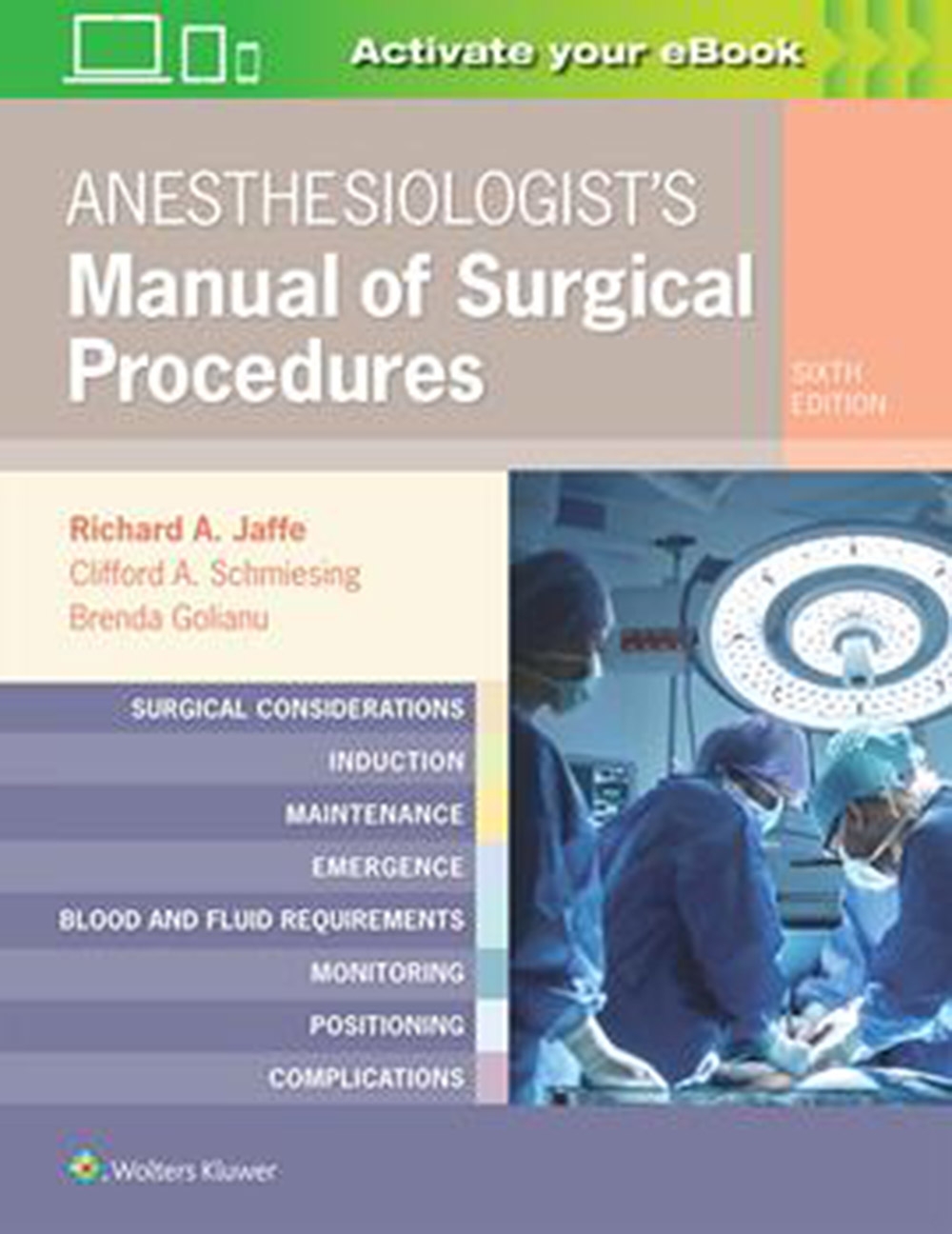Covering both surgical and anesthetic considerations, Anesthesiologist’s Manual of Surgical Procedures, Sixth Edition, is an essential resource for formulation of an anesthetic plan and perioperative management of patients. All chapters are written by both surgeons and anesthesiologists, giving you a detailed, real-world perspective on the many variables that accompany today’s surgical procedures.
•Presents preoperative, intraoperative, and postoperative anesthetic considerations in a clear, templated format, summarizing all courses of action in easy-to-read tables.
•Describes what the surgeon will likely be doing, variants of the procedure or approaches, patient population characteristics, and details of the procedure including positioning, length of procedure, postop care, and more.
•Features a full-color design to enhance readability of the tables and clarity of the illustrations.
•Updates to this edition include a new, heavily illustrated chapter overviewing regional blocks and new appendices covering individual components of enhanced recovery (ERAS) protocols and intraoperative use of transnasal humidified rapid-insufflation ventilatory exchange (THRIVE); as well as new, rapidly accessible tables and figures set on the inside back cover reviewing useful, but easily forgotten facts and dermatomes.
•An ideal reference for anesthesiologists, anesthesia residents, and CRNAs.
Enrich Your eBook Reading Experience
•Read directly on your preferred device(s), such as computer, tablet, or smartphone.
•Easily convert to audiobook, powering your content with natural language text-to-speech.
| FindBook |
有 1 項符合
Anesthesiologist’s Manual of Surgical Procedures的圖書 |
 |
Anesthesiologist’s Manual of Surgical Procedures 作者:Richard A. Jaffe、Clifford A Schmiesing、Brenda Golianu 出版社:九州 出版日期:2019-12-06 語言:英文 規格:精裝 / 1952頁 / 22 x 28 x 27.33 cm / 普通級 / 單色印刷 / 6版 |
| 圖書館借閱 |
| 國家圖書館 | 全國圖書書目資訊網 | 國立公共資訊圖書館 | 電子書服務平台 | MetaCat 跨館整合查詢 |
| 臺北市立圖書館 | 新北市立圖書館 | 基隆市公共圖書館 | 桃園市立圖書館 | 新竹縣公共圖書館 |
| 苗栗縣立圖書館 | 臺中市立圖書館 | 彰化縣公共圖書館 | 南投縣文化局 | 雲林縣公共圖書館 |
| 嘉義縣圖書館 | 臺南市立圖書館 | 高雄市立圖書館 | 屏東縣公共圖書館 | 宜蘭縣公共圖書館 |
| 花蓮縣文化局 | 臺東縣文化處 |
|
|
圖書介紹 - 資料來源:博客來 評分:
圖書名稱:Anesthesiologist’s Manual of Surgical Procedures
內容簡介
作者介紹
作者簡介
Richard A. Jaffe MD, PhD
Professor of Anesthesiology and Neurosurgery
Chief, Neurosurgical Anesthesia Service
Stanford University School of Medicine
Stanford, California
Clifford A Schmiesing MD
Associate Clinical Professor, Anesthesiology, Perioperative and Pain Medicine
Co-Director Anesthesia, Preoperative Assessment Clinic
Stanford University School of Medicine
Stanford, California
Brenda Golianu MD
Assistant Professor of Anesthesia
Stanford University School of Medicine
Stanford, California
Richard A. Jaffe MD, PhD
Professor of Anesthesiology and Neurosurgery
Chief, Neurosurgical Anesthesia Service
Stanford University School of Medicine
Stanford, California
Clifford A Schmiesing MD
Associate Clinical Professor, Anesthesiology, Perioperative and Pain Medicine
Co-Director Anesthesia, Preoperative Assessment Clinic
Stanford University School of Medicine
Stanford, California
Brenda Golianu MD
Assistant Professor of Anesthesia
Stanford University School of Medicine
Stanford, California
目錄
1.0 Neurosurgery
1.1 Intracranial Neurosurgery
1.2 Functional Neurosurgery
1.3 Spinal Neurosurgery
1.4 Carotid Endarterectomy
2.0 Ophthalmic Surgery
3.0 Otolaryngology-Head and Neck Surgery
4.0 Dental Surgery
5.0 Thoracic Surgery
6.0 Cardiovascular Surgery
6.1 Cardiac Surgery
6.2 Minimally Invasive Cardiac Surgery
6.3 Vascular Surgery
6.4 Heart/Lung Transplantation
7.0 General Surgery
7.1 Esophageal Surgery
7.2 Stomach Surgery
7.3 Intestinal Surgery
7.4 Colorectal Surgery
7.5 Hepatic Surgery
7.6 Biliary Tract Surgery
7.7 Laparoscopic General Surgery
7.8 Pancreatic Surgery
7.9 Peritoneal Surgery
7.10 Breast Surgery
7.11 Endocrine Surgery
7.12 Liver/Kidney/Pancreas Transplantation
7.13 Trauma Surgery
8.0 Obstetric/Gynecologic Surgery
8.1 Gynecologic Oncology
8.2 Gynecology/Infertility Surgery
8.3 Obsteric Surgery
8.4 Laparoscopic Procedures with and Without Robotic Assistance for Gynecologic Surgery
9.0 Urology
10.0 Orthopedic Surgery
10.1 Hand Surgery
10.2 Shoulder/Arm Surgery
10.3 Spinal Surgery
10.4 Hip, Pelvis, and Upper Leg Surgery
10.5 Knee Surgery
10.6 Lower Leg, Ankle, Foot, and Other Lower-Extremity Procedures
11.0 Plastic and Reconstructive Surgery
11.1 Facial Cosmetic Surgery
11.2 Nonfacial Anesthetic Surgery
11.3 Craniofacial Surgery
11.4 Functional Restoration
11.5 Burn Surgery
12.0 Pediatric Surgery
12.1 Pediatric Neurosurgery
12.2 Pediatric Ophthalmic Surgery
12.3 Pediatric Otolaryngology
12.4 Pediatric Cardiovascular Surgery
12.5 Pediatric General Surgery
12.6 Pediatric Urology
12.7 Pediatric Orthopedic Surgery
12.8 Surgery for Craniofacial Malformations
12.9 Pediatric Transplanation
13.0 Non-Operating Room Procedures
13.1 Non-Operating Room Procedures: Adults
13.2 Non-Operating Room Procedures: Pediatric
14.0 Office-Based Anesthesia
15.0 Emergency Procedures for the Anesthesiologist
16.0 Regional Blocks-A brief Overview
Appendices A-1
Subject Index
1.1 Intracranial Neurosurgery
1.2 Functional Neurosurgery
1.3 Spinal Neurosurgery
1.4 Carotid Endarterectomy
2.0 Ophthalmic Surgery
3.0 Otolaryngology-Head and Neck Surgery
4.0 Dental Surgery
5.0 Thoracic Surgery
6.0 Cardiovascular Surgery
6.1 Cardiac Surgery
6.2 Minimally Invasive Cardiac Surgery
6.3 Vascular Surgery
6.4 Heart/Lung Transplantation
7.0 General Surgery
7.1 Esophageal Surgery
7.2 Stomach Surgery
7.3 Intestinal Surgery
7.4 Colorectal Surgery
7.5 Hepatic Surgery
7.6 Biliary Tract Surgery
7.7 Laparoscopic General Surgery
7.8 Pancreatic Surgery
7.9 Peritoneal Surgery
7.10 Breast Surgery
7.11 Endocrine Surgery
7.12 Liver/Kidney/Pancreas Transplantation
7.13 Trauma Surgery
8.0 Obstetric/Gynecologic Surgery
8.1 Gynecologic Oncology
8.2 Gynecology/Infertility Surgery
8.3 Obsteric Surgery
8.4 Laparoscopic Procedures with and Without Robotic Assistance for Gynecologic Surgery
9.0 Urology
10.0 Orthopedic Surgery
10.1 Hand Surgery
10.2 Shoulder/Arm Surgery
10.3 Spinal Surgery
10.4 Hip, Pelvis, and Upper Leg Surgery
10.5 Knee Surgery
10.6 Lower Leg, Ankle, Foot, and Other Lower-Extremity Procedures
11.0 Plastic and Reconstructive Surgery
11.1 Facial Cosmetic Surgery
11.2 Nonfacial Anesthetic Surgery
11.3 Craniofacial Surgery
11.4 Functional Restoration
11.5 Burn Surgery
12.0 Pediatric Surgery
12.1 Pediatric Neurosurgery
12.2 Pediatric Ophthalmic Surgery
12.3 Pediatric Otolaryngology
12.4 Pediatric Cardiovascular Surgery
12.5 Pediatric General Surgery
12.6 Pediatric Urology
12.7 Pediatric Orthopedic Surgery
12.8 Surgery for Craniofacial Malformations
12.9 Pediatric Transplanation
13.0 Non-Operating Room Procedures
13.1 Non-Operating Room Procedures: Adults
13.2 Non-Operating Room Procedures: Pediatric
14.0 Office-Based Anesthesia
15.0 Emergency Procedures for the Anesthesiologist
16.0 Regional Blocks-A brief Overview
Appendices A-1
Subject Index
序
序
The goals of this sixth edition remain unchanged from those of the first-that is, to provide an easily accessible source of clinically relevant information about a wide variety of common and not-so-common surgical and nonsurgical procedures requiring anesthesia. A with the first edition, this edition does not pretend to be either a textbook of anesthesia or a textbook of surgery. Inded, in the formulation of any anesthetic plan, there is no substitute for experience and sound clinical judgment.
Those familiar with the preceding editions will notice that the format and organization of this edition remain largely unchanged. Along with the addition of new procedures, every existing procedure was carefully reviewed and revised to reflect current practice. W continue to expand thee use of color to improve readability of the tables and clarity of the figures. New to this edition is an emphasis on common sense enhanced recovery considerations that we believe can be applied perioperatively to most patients undergoing most surgical procedures. Also new to this edition is a chapter reviewing the basic principles and anatomy of common regional anesthetic techniques, an appendix reviewing individual components of enhanced recovery (ERAS) protocols, including fluid management and multimodal pain management, an appendix describing the intraoperative use of Transnasal Humidified Rapid-Insufflation Ventilatory Exchane (THRIVE), and a collection of interesting facts and figures printed on the inside cove pages.
The goals of this sixth edition remain unchanged from those of the first-that is, to provide an easily accessible source of clinically relevant information about a wide variety of common and not-so-common surgical and nonsurgical procedures requiring anesthesia. A with the first edition, this edition does not pretend to be either a textbook of anesthesia or a textbook of surgery. Inded, in the formulation of any anesthetic plan, there is no substitute for experience and sound clinical judgment.
Those familiar with the preceding editions will notice that the format and organization of this edition remain largely unchanged. Along with the addition of new procedures, every existing procedure was carefully reviewed and revised to reflect current practice. W continue to expand thee use of color to improve readability of the tables and clarity of the figures. New to this edition is an emphasis on common sense enhanced recovery considerations that we believe can be applied perioperatively to most patients undergoing most surgical procedures. Also new to this edition is a chapter reviewing the basic principles and anatomy of common regional anesthetic techniques, an appendix reviewing individual components of enhanced recovery (ERAS) protocols, including fluid management and multimodal pain management, an appendix describing the intraoperative use of Transnasal Humidified Rapid-Insufflation Ventilatory Exchane (THRIVE), and a collection of interesting facts and figures printed on the inside cove pages.
|











